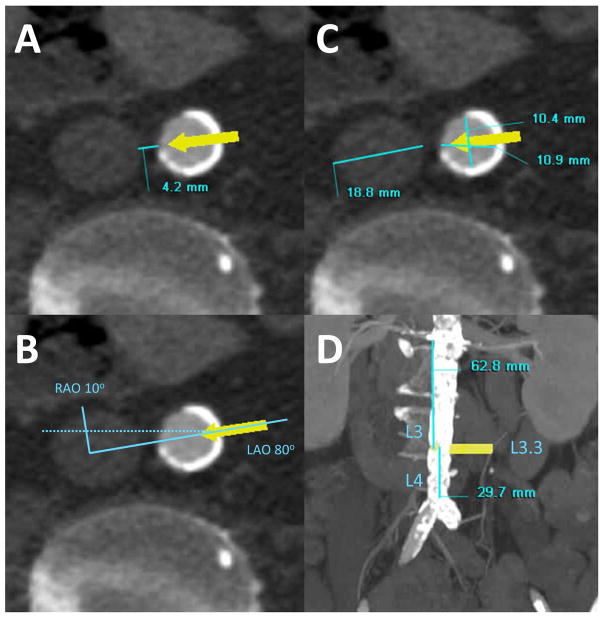Figure 4. Obtain key measurements.
(Panel A) The lumen-to-lumen distance between the aorta and inferior vena cava at the target, measured horizontally (include interposed aortic atheroma or thrombus). The commercially available nitinol occluder devices have a neck length of 7–8 mm. Tracts longer than 8–12mm may be less favorable and distances exceeding 12mm are unfavorable for transcaval procedures using currently available occluder devices. (Panel B) The recommended working fluoroscopic projection angles for crossing and corresponding orthogonal projection for pointing at the aortic snare. The angle is measured between the cava and aortic centers while the patient is lying flat. (Panel C) The diameter of the inferior vena cava and aorta at the target. This is measured along the line connecting the cava and aortic centers, and is used to choose a suitable caval guiding catheter and choose an oversized snare device that will seat properly to create a “bullseye” target during transcaval crossing. (Panel D) The lumbar spine landmark corresponding to the proposed crossing target. Depict these landmarks in a coronal oblique view at the recommended projection angle, and in a straight sagittal view. We report a semi-quantitative location score, where the mid-body of the 3rd lumbar vertebra is called L3.0, and the middle of the intervertebral disc between L3 and L4 is called L3.5. We identify bailout options including the diameter of the aorta above and below the target (typically ± 3cm), and the “best” iliofemoral artery side to be used in case emergency endograft therapy is required. These measurements inform the choice of endograft device. The distance of the proposed target from the right renal artery and the top of the aorto-iliac bifurcation. This helps the operator assure the closure device will not interfere with either vascular structure. The trajectory distance from the femoral vein skin puncture into the aortic target must be significantly less (by approximately 7cm) than the working length of the selected introducer sheath, even in obese patients.

